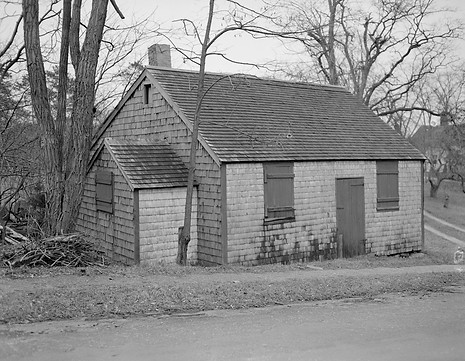

Fulling Mill 1937

Fulling Mill and Carding Mill
By Jim Gould
FULLING MILL and CARDING MILL (west of the southern portion of Route 149): Marstons Mills got its name from the Marston fulling mill and its neighboring mills. A fulling mill was a kind of a giant washing machine that scrubbed the oil and dirt out of the raw wool taken from recently shorn sheep and pounded the loose fibers into a solid mat. A water wheel turned a horizontal shaft that rotated tippet arms to push twin beams attached to mallets that were as big as a man. These huge mallets alternately pounded on the wool in a two-foot-high stock or tub. The racket caused by the pounding hammers was notorious, as we know from the fictional tale of Don Quixote, who mistook the hideous sound from a mill to be the tromping of bearded giants. The solvent added to water in the tub was fuller's earth, a clay found in abundance at Gay Head on Martha's Vineyard. The Wampanoags used it to launder their blankets and cloches.
After the mill had cleaned the wool and pounded it to an even thickness, the wet cloth was stretched between two horizontal cedar poles and fastened at the top and bottom by iron tenterhooks (hence the saying, "being on tenterhooks"). We can imagine long, fencelike tenteryards on the field and hillside below the mill.
Close by the fulling mill was the Carding Mill, propelled by the same wheel, where the nap was raised, or teased by teasels--a thistle-like plant pod--and later by metal hooks. Next the cloth was smoothed on a table with razor sharp shears. Then came dye vats, located perhaps where the present pond is.
The Marstons Mills fulling mill, authorized in 1687, is one of the earliest in America. It was the second on Cape Cod and in southern Massachusetts, following the Nye mill in Sandwich in 1676. The first American fulling mill had been started in the town of Rowley in 1643, followed by Watertown 1662, Andover 1673, Ipswich and Salem 1675 and Dedham 1681. The Barnstable Town Meeting of February 11, 1686/7 gave John Andreas eight or ten acres of upland next to John Goodspeed's property on the river "to full Cloth provided he set up and keep a fulling mill and full and Dress ye Towns Cloth Upon Reasonable Terms or Prices." John's father, Roger, had founded the village in 1648). The property was located on the east side of the Herring River (then called Goodspeed's), well above today's road named Fulling Mill Lane. The river was dammed about where the public footbridge crosses the river to Willow Dell, forming a pond that extended up to where River Road crosses the stream.
A sluiceway fed a mill race below the former Loring Jones house (#145 River Road) to the mill below the Pierce house (#105 River Road).
The first miller, John Andreas, may have been a skilled operator from the North Shore, but construction required capital. In 1688, the town gave 8-to-10 acres to ten proprietors of Barnstable, all of them from the north side except for Joseph Crocker of Santuit and mill site neighbor John Goodspeed. By the terms of the agreement, they had to build the mill and maintain it for 20 years, providing the service to any townsperson who brought his raw wool to the site.
The early history of this mill was told by our local historian Vivian Cushing in the bicentennial history, The Seven Villages of Barnstable. By March 1691, the mill was working under Thomas Massey (or Marcy, Macy?), to whom the town gave 5 ½ acres near the mill. The resident owner of the mill, John Goodspeed's niece Lydia, married Benjamin Marston in 1716. He was a third-generation carpenter from Salem, who may have rebuilt the fulling mill on the model of those already operating on the North Shore. Before his death in 1769, he had added spinning and weaving machines in buildings below the mill. Marstons Mills was thus already a major industrial village even before the American Revolution.
Benjamin Marston, the first Marston in Marstons Mills, left the clothing business and tools to his son Prince Marston, born 1735, who managed the factory until his death in 1775 at the early age of 40. Prince's son, Isaiah, was only 18, but he took over the wool manufacturing until 1801 when he moved to Waterville, Maine, where he built a mill.
The operation and ownership of the mill in the early nineteenth century is confused and fragmented. The actual owner-operator from 1792 to after 1818 was the clothier, John Gallison, of Yarmouth. Then, from 1818 to 1829, it was the dyer, Robert Francis. At the same time, the Marstons were active clothiers, that is, wool manufacturers.
In 1829, the last owner-operator bought a share in the mills. This was Nathaniel Hinckley, the first Postmaster of Marstons Mills and storekeeper, owner of three grist mills in the area, sheriff and register of probate, ten times a Representative on Beacon Hill at the Massachusetts State Legislature and wealthy land owner. The Marstons sold him their share in 1832 ending more than 115 years of profitable involvement by the family. Hinckley expanded the mill, installing some of the newly invented textile machinery. In 1852, he took on as partner Rufus Churchill, who produced cotton batting. The death of Churchill's son in 1855 ended the operation entirely.
The Abandoned factory buildings were probably reused. Derelict remains were washed away in the periodic floods of the river. Today all we see is the marker put by the Tercentenary Committee at the lower pond which is today’s Mill Pond at the intersection of Routes 149 and 28 a quarter of a mile downstream from the old fulling mill. (Barnstable Enterprise 17 Dec. 2010)


